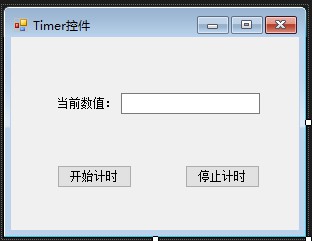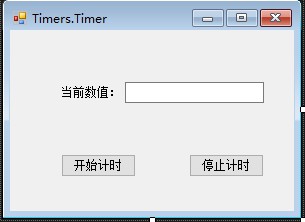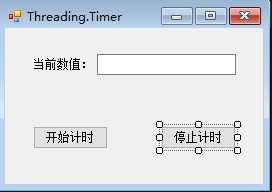C#中的三种定时计时器Timer
.NET开发菜鸟 人气:0在.NET中有三种计时器:
- 1、System.Windows.Forms命名空间下的Timer控件,它直接继承自Componet。Timer控件只有绑定了Tick事件和设置Enabled=True后才会自动计时,停止计时可以用Stop()方法控制,通过Stop()停止之后,如果想重新计时,可以用Start()方法来启动计时器。Timer控件和它所在的Form属于同一个线程;
- 2、System.Timers命名空间下的Timer类。System.Timers.Timer类:定义一个System.Timers.Timer对象,然后绑定Elapsed事件,通过Start()方法来启动计时,通过Stop()方法或者Enable=false停止计时。AutoReset属性设置是否重复计时(设置为false只执行一次,设置为true可以多次执行)。Elapsed事件绑定相当于另开了一个线程,也就是说在Elapsed绑定的事件里不能访问其它线程里的控件(需要定义委托,通过Invoke调用委托访问其它线程里面的控件)。
- 3、System.Threading.Timer类。定义该类时,通过构造函数进行初始化。
在上面所述的三种计时器中,第一种计时器和它所在的Form处于同一个线程,因此执行的效率不高;而第二种和第三种计时器执行的方法都是新开一个线程,所以执行效率比第一种计时器要好,因此在选择计时器时,建议使用第二种和第三种。
下面是三种定时器使用的例子:
1、Timer控件
设计界面:

后台代码:
using System;
using System.Collections.Generic;
using System.ComponentModel;
using System.Data;
using System.Drawing;
using System.Linq;
using System.Text;
using System.Windows.Forms;
namespace TimerDemo
{
public partial class FrmMain : Form
{
//定义全局变量
public int currentCount = 0;
public FrmMain()
{
InitializeComponent();
}
private void FrmMain_Load(object sender, EventArgs e)
{
//设置Timer控件可用
this.timer.Enabled = true;
//设置时间间隔(毫秒为单位)
this.timer.Interval = 1000;
}
private void timer_Tick(object sender, EventArgs e)
{
currentCount += 1;
this.txt_Count.Text = currentCount.ToString().Trim();
}
private void btn_Start_Click(object sender, EventArgs e)
{
//开始计时
this.timer.Start();
}
private void btn_Stop_Click(object sender, EventArgs e)
{
//停止计时
this.timer.Stop();
}
}
}2、System.Timers.Timer
设计界面:

后台代码:
using System;
using System.Collections.Generic;
using System.ComponentModel;
using System.Data;
using System.Drawing;
using System.Linq;
using System.Text;
using System.Windows.Forms;
namespace TimersTimer
{
public partial class FrmMain : Form
{
//定义全局变量
public int currentCount = 0;
//定义Timer类
System.Timers.Timer timer;
//定义委托
public delegate void SetControlValue(string value);
public FrmMain()
{
InitializeComponent();
}
private void Form1_Load(object sender, EventArgs e)
{
InitTimer();
}
/// <summary>
/// 初始化Timer控件
/// </summary>
private void InitTimer()
{
//设置定时间隔(毫秒为单位)
int interval = 1000;
timer = new System.Timers.Timer(interval);
//设置执行一次(false)还是一直执行(true)
timer.AutoReset = true;
//设置是否执行System.Timers.Timer.Elapsed事件
timer.Enabled = true;
//绑定Elapsed事件
timer.Elapsed += new System.Timers.ElapsedEventHandler(TimerUp);
}
/// <summary>
/// Timer类执行定时到点事件
/// </summary>
/// <param name="sender"></param>
/// <param name="e"></param>
private void TimerUp(object sender, System.Timers.ElapsedEventArgs e)
{
try
{
currentCount += 1;
this.Invoke(new SetControlValue(SetTextBoxText),currentCount.ToString());
}
catch (Exception ex)
{
MessageBox.Show("执行定时到点事件失败:" + ex.Message);
}
}
/// <summary>
/// 设置文本框的值
/// </summary>
/// <param name="strValue"></param>
private void SetTextBoxText(string strValue)
{
this.txt_Count.Text = this.currentCount.ToString().Trim();
}
private void btn_Start_Click(object sender, EventArgs e)
{
timer.Start();
}
private void btn_Stop_Click(object sender, EventArgs e)
{
timer.Stop();
}
}
}3、System.Threading.Timer
设计界面:

后台代码:
using System;
using System.Collections.Generic;
using System.ComponentModel;
using System.Data;
using System.Drawing;
using System.Linq;
using System.Text;
using System.Windows.Forms;
using System.Threading;
namespace Threading.Timer
{
public partial class FrmMain : Form
{
//定义全局变量
public int currentCount = 0;
//定义Timer类
System.Threading.Timer threadTimer;
//定义委托
public delegate void SetControlValue(object value);
public FrmMain()
{
InitializeComponent();
}
private void FrmMain_Load(object sender, EventArgs e)
{
InitTimer();
}
/// <summary>
/// 初始化Timer类
/// </summary>
private void InitTimer()
{
threadTimer = new System.Threading.Timer(new TimerCallback(TimerUp), null, Timeout.Infinite, 1000);
}
/// <summary>
/// 定时到点执行的事件
/// </summary>
/// <param name="value"></param>
private void TimerUp(object value)
{
currentCount += 1;
this.Invoke(new SetControlValue(SetTextBoxValue), currentCount);
}
/// <summary>
/// 给文本框赋值
/// </summary>
/// <param name="value"></param>
private void SetTextBoxValue(object value)
{
this.txt_Count.Text = value.ToString();
}
/// <summary>
/// 开始
/// </summary>
/// <param name="sender"></param>
/// <param name="e"></param>
private void btn_Start_Click(object sender, EventArgs e)
{
//立即开始计时,时间间隔1000毫秒
threadTimer.Change(0, 1000);
}
/// <summary>
/// 停止
/// </summary>
/// <param name="sender"></param>
/// <param name="e"></param>
private void btn_Stop_Click(object sender, EventArgs e)
{
//停止计时
threadTimer.Change(Timeout.Infinite, 1000);
}
}
}代码下载链接:点此下载
到此这篇关于C#中的三种定时计时器Timer用法的文章就介绍到这了。希望对大家的学习有所帮助,也希望大家多多支持。
加载全部内容